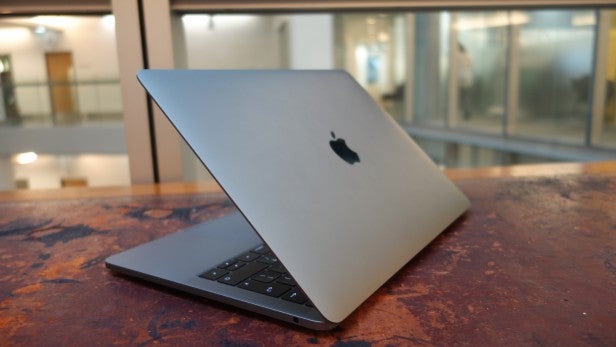MacBook Pro 2016 Review - Performance, battery life and screen Review
Performance, battery life and screen
A stunning laptop and a compromised experience
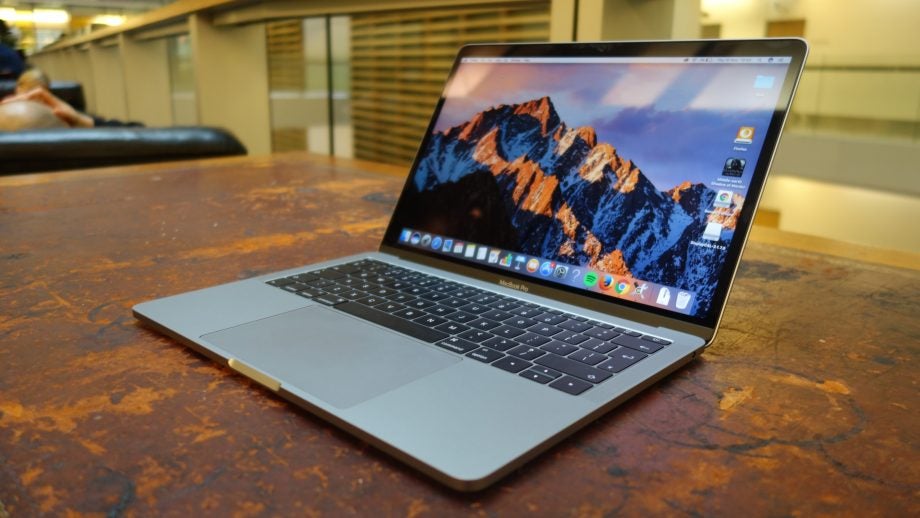
Sections
- Page 1 MacBook Pro 2016 Review
- Page 2 Performance, battery life and screen Review
MacBook Pro 2016 – Performance
So far, so great – but processor performance is perhaps the biggest stumbling block with this MacBook Pro 2016.
The base model in the lineup features a newer processor over last year’s entry-level device, upgrading from a fifth-gen Intel Broadwell up to a sixth-gen Intel Skylake. The base clock speed of the chip has been reduced from 2.7GHz to 2GHz, although the maximum Turbo Boost speed is the same 3.1GHz.
You might notice that Apple hasn’t used Intel’s seventh-gen Kaby Lake processors. This is simply down to Intel’s rollout of the chips; the dual-core models with Intel Iris Graphics on board aren’t available yet. Let’s hope for a mid-year Kaby Lake refresh in 2017.
Theoretically, this model shouldn’t be any slower than last year’s model, as long as Apple’s cooling system is up to par and the processor is able to run at maximum speeds when the going gets tough. All of this is paired with 8GB of LPDDR3 memory running at 1866MHz.
As ever with Apple, there’s a wealth of customisation options available, but they’ll add a hefty chunk to your bill. The biggest performance upgrade you can make is to ditch the Core i5 processor and upgrade it to a dual-core Core i7 chip that has a higher maximum clock speed of 3.4GHz. This will set you back £270. You can also double the memory allocation to 16GB for a rather steep £180, and expand the SSD to 512GB for £180 or 1TB for £540.
Related: Intel Core i processors explained
The chip itself is an Intel Core i5-6360U, which is comparable to the i5-6300U you’ll often see in Windows laptops. It has a slightly higher power draw than the 6300U, thanks to its higher boost clock speed, and it also gets Intel Iris Graphics 540 instead of Intel HD Graphics 520. Iris is much more competent when working with video and 3D workloads.
Under fairly sedate usage, the MacBook Pro is near-silent. Editing documents and browsing the web in the office, I never once heard a peep from the Pro – although the wrist rest remained fairly warm throughout. Even when editing Full HD video in Adobe Premier, it stayed whisper quiet. A genuinely impressive feat.
I wasn’t blown away by its performance in everyday tasks, however, with a very occasional stutter creeping in when browsing the web and loading image-heavy webpages. Still, for the most part, performance was butter-smooth, which is largely down to the superb hardware and software integration. 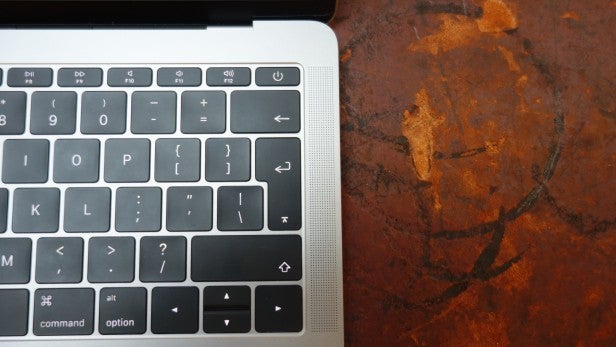
In Geekbench 3, the 2016 MacBook Pro put in almost identical scores to last year’s model, with results of 3,300 and 6,947 in the single- and multi-core tests respectively. As a result, if you have last year’s bottom-spec model then there will be no reason to upgrade.
Note that its score is also nearly identical to the Lenovo IdeaPad 710S that TrustedReviews put through its paces a few months ago, although that machine came equipped with a more powerful Intel Core i7 processor.
Up against the Core i7-7700U found in the high-end 2016 Dell XPS 13 it’s slower in both tests, with the Dell netting higher scores of 3,600 and 7,675.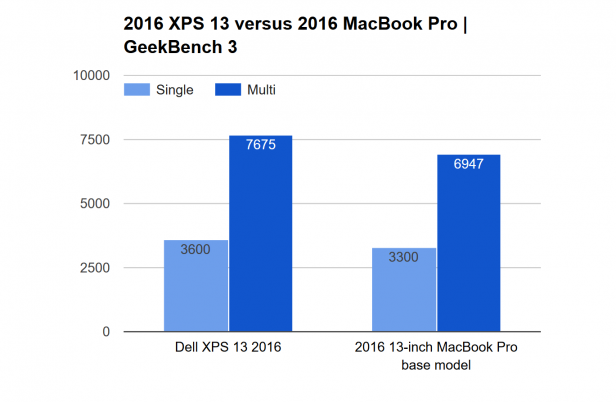
But how does it fare in real-world use? For both this review and that of the 2016 Dell XPS 13, I set our in-house video editor, Tom Honeyands, the task of editing the same video review in Adobe Premier.
Both machines handled live playback of 1080p video with captions overlaid just fine, and were quick and smooth to scrub through footage. However, when the time came to export the three-minute video, the MacBook Pro took more than seven minutes to complete the task, while the Dell was done in just over five. With bigger projects, these render times will start to take their toll.
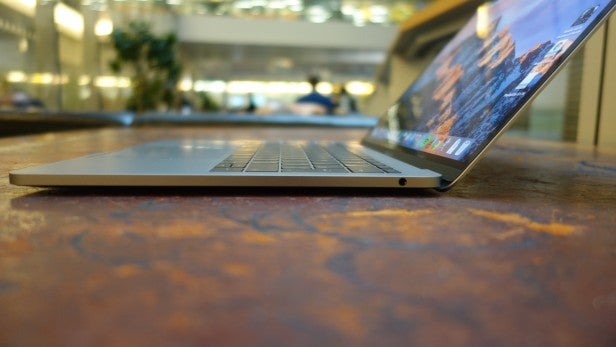
In fairness, it isn’t a surprising result when you consider the higher clock speeds of the Dell XPS 13’s higher-performance processor, but it’s a worthwhile comparison because that machine is so much cheaper (£300 cheaper on a Full HD Dell XPS 13 and £150 on a 3K model).
It’s also important to note that Adobe Premier runs smoother on macOS than it does on Windows; there are various UI elements – including the timeline – that perform better.
The SSD is a different story; in the BlackMagic SSD benchmark, the MacBook Pro topped out on read speeds at 2,000MB/sec (it’s capable of more, but the benchmark can’t handle it) and managed 1,700MB/sec write speeds.
This is the fastest SSD I’ve ever seen in a laptop, but the ridiculous speed feels like it’s wasted on what is a middling processor. Would Apple have been better to compromise SSD performance to create a cheaper and, thus, better balanced laptop? I think so.
Related: MacOS Sierra review
MacBook Pro 2016 – Battery life
Battery life has always been a strong point of the MacBook Pro, and it’s no different here. The unit on board the base model is actually slightly larger than that found in the high-end option, but Apple rates both machines at 10 hours.
With my fairly moderate usage – which includes emails, browsing and editing a few images – I was able to get between nine and 10 hours on a normal day, with the screen at around three-quarters brightness.
In TrustedReviews’ Netflix test, where the laptop is set to play an hour of streaming video at 150-nits brightness, the MacBook consumed 13% of the battery. This is good for nearly eight hours of video playback, which is a great result.
Your mileage will vary significantly if you’re editing pictures or videos while away from the mains, so you’ll probably want to take the small power brick and USB Type-C charging cable with you.
One nice perk is that the battery charges extremely fast. I was able to bring it up from 15% to 75% in well under an hour, even while it was switched on and in use.
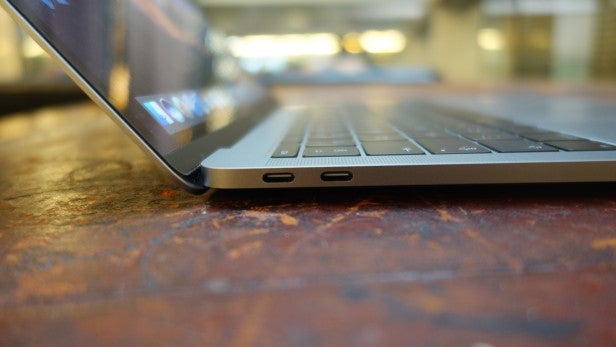
MacBook Pro 2016 – Screen
The MacBook Pro’s 13.3-inch screen is a tour de force in laptop displays. It’s a 2,560 x 1,600 panel, which is the same as last year’s device – but in every other respect it’s been upgraded.
First, the brightness. According to my measurements, the screen tops out at an eye-searing 548 nits. This is well beyond your average high-end laptop, which would normally max out at around 350 nits. Contrast is similarly impressive: I recorded 0.37-nit black levels, which equates to a 1,457:1 contrast ratio. As a result, bright colours and subtle shades are served brilliantly by the display.
Colour gamut coverage is class-leading, too. I recorded 99% sRGB coverage, 98.3% DCI-P3 coverage and 81.9% Adobe RGB coverage. Last year’s MacBook Pro only managed to fully cover the much smaller sRGB gamut, while this year’s focuses on DCI P3. DCI P3 is the standard when it comes to HDR content, which is why we’re starting to see more screens calibrated to that colour standard. Full Adobe RGB coverage, favoured by professional photographers, is still a way off and requires an ultra-high-end external monitor.
The more colours a screen can display, the more accurate images shown on the screen are. Instead of substituting a vibrant colour for a duller one, as would happen on a cheaper screen, even the most vibrant colours are shown as intended. It’s particularly important for creatives such as photographers, video editors and digital painters because seeing the finished product as accurately as possible makes a big difference.
MacBook Pro 2016 – Speakers, webcam and microphone
The speakers on the MacBook Pro are among the best of any laptop I’ve used. They fire upwards with both exceptional clarity and loudness, and manage to serve the mid-range and trebles very well. There’s even a fair amount of bass when you turn up the volume, which is genuinely impressive.
The built-in microphone is equally good, picking up voices nicely without thinning them out and removing the warmth. I’m slightly less impressed with the webcam, which can be pretty noisy and not hugely forgiving when the subject is backlit. Together, though, the webcam and mic do a good job for video chats.
Should I buy the MacBook Pro 2016?
If you buy a base model MacBook Pro 2016, you won’t be disappointed. In fact, you’ll probably fall in love with it. It’s the cheapest way to get a properly powerful MacOS device, which is probably the most important item in the Pro column at this stage. Still with only two ports and a high up-front cost, it’s not a no-brainer.
Update, October 2017: Since my original review of the MacBook Pro, the market has changed a little. Not least because Intel has launched its new line of 8th-generation Core i processors. These new chips launched in August 2017, and the biggest change is that the number of cores on low-power laptop chips have doubled from two to four for up to 40% extra performance. Apple has made no mention of putting 8th-gen processors in its MacBook Pros, and you wouldn’t normally expect an Apple product refresh for a few months.
If you’re operating-system agnostic, the Dell XPS 13 has already been upgraded to 8th-gen processors, meaning it’ll be substantially more powerful than its MacBook Pro equivalent. Keep in mind that the MacBook Pro is hardly slow to start with, but if raw power is what you’re after, the XPS 13 delivers right now.
Verdict
The 13-inch MacBook Pro 2016 is the best-designed laptop in the world, without question. Just consider whether you’re willing to pay for it.
How we test laptops
Unlike other sites, we test every laptop we review thoroughly over an extended period of time. We use industry standard tests to compare features properly. We’ll always tell you what we find. We never, ever, accept money to review a product.
Trusted Score
Score in detail
-
Performance 7
-
Keyboard 9
-
Design 9
-
Screen Quality 10
-
Build Quality 10
-
Value 7
-
Touchpad 10
-
Heat & Noise 9
-
Battery Life 9


